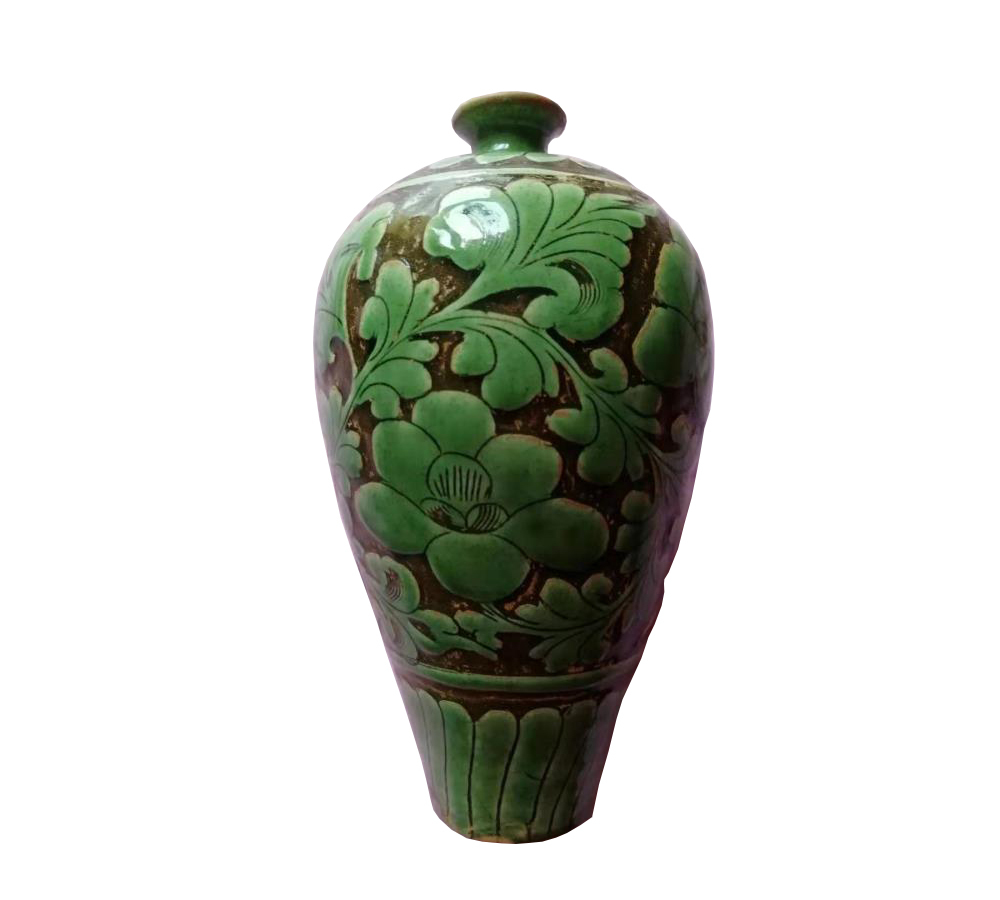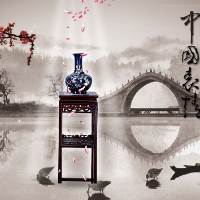罕见南宋绿釉刻花梅瓶
绿釉以氧化铜为着色剂,铅化合物作为助熔剂的低温釉。汉代低温铅绿釉陶的釉料中就含有2.6%的氧化铜。宋、金除烧制低温绿釉陶器外,还烧制绿釉瓷器,如磁州窑、吉州窑、定窑等,定窑所烧制的绿釉瓷器又称为“绿定”。元、明绿釉器有孔雀绿釉,明还烧造瓜皮绿釉器。清康、雍、乾时期绿釉器的烧制到达鼎盛,色彩丰厚,有郎窑绿、瓜皮绿、西湖水、孔雀绿釉等。
梅瓶是中国古瓷中常见的一种外型,是对小口、短颈、丰肩、窄胫一类外型瓷瓶的总称。梅瓶的近足处微外撇,形成了细长美丽的S形曲线,因此遭到人们耐久喜爱,其外型还远播到朝鲜半岛和日本。除了有许多梅瓶什物保存下来,在古代绘画和雕塑里也有一些反映古人运用梅瓶的场景,这些图象对我们准确知道梅瓶用途、外型演化很有协助,也是断定古瓷的首要参照。
北宋赵令畤《侯鲭录》记载:“陶人之为器,有酒经焉。晋安人盛酒似瓦壶之制,小颈,环口,修腹,受一斗,可以盛酒。凡馈人牲,兼云以酒器,书云就一经或五经焉。他境人有游所以邦,不达其义,闻五经至,束带迎于门,乃知是酒五瓶为五经焉”。许多专家以为,这种可装酒一斗、名为“酒经”的小口修腹瓷瓶,很或许便是宋代人对梅瓶的称谓,因此宋代的梅瓶也可称作“经瓶”。到了元明期间,从古人的诗文分析,此刻的梅瓶或许被称为酒“樽”、“”酒瓶。
金代和南宋时,还出现一种口部稍大的新样式梅瓶。这种大口梅瓶在耀州窑北宋晚期到金代前期曾有烧造,窑址中发掘出土过多件。
通体表里施绿釉,釉色厚腴温润,釉面滋润匀净,碧翠怡人,极得素雅匀净之美,此瓶形制周正,刻工娴熟,刀法流通,气脉连接,此为南宋时期产品,存世量甚少,保存至今无缺,具有历史价值,文化价值,经济价值。保藏价值极高。

Green glaze a low temperature glaze with copper oxide as colorant and lead compound as flux. The glaze of low-temperature lead green glazed pottery in the han dynasty contained 2.6% copper oxide. In addition to firing low-temperature green glaze pottery, song and jin also fired green glaze porcelain, such as cizhou kiln, jizhou kiln and dingyao kiln. The green glaze porcelain fired by dingyao kiln is also known as "lvding". Yuan, bright green glaze with malachite green glaze, Ming also baked melon skin green glaze. During the periods of qing kang, yong and gan, the firing of green glaze reached its peak with rich colors, such as lang kiln green, melon skin green, west lake water and peacock green glaze.
Plum vase is a common shape in ancient Chinese porcelain. It is a general term for porcelain vessels with small mouth, short neck, large shoulders and narrow shank. The plum vase is durable and popular because of its elongated and beautiful s-shaped curve, which is slightly curved at the foot of the plum vase, and its appearance has been spread as far as the Korean peninsula and Japan. In addition to the many preserved plum vase items, there are also scenes in ancient paintings and sculptures that reflect the use of plum vase by the ancients. These images are very helpful for us to accurately know the use and appearance evolution of plum vase, and are also the primary reference for the determination of ancient porcelain.
Northern song dynasty Zhao Lingzhi "hou mackerel record" records: "TaoRen as, some alcohol. Jin 'an people hold wine like clay pot system, small neck, ring mouth, repair stomach, by a bucket, can hold wine. Every animal that feeds man, and the cloud that drinketh wine, and the cloud that writteneth, or the five sutras. He heard the five classics and greeted the door with a girdle. He knew that five bottles of wine were the five classics. Many experts believe that this kind of porcelain vase, which can hold a bucket of wine and is called "jingjing", is probably the name of the plum vase in the song dynasty, so the plum vase in the song dynasty can also be called "jingping". To the yuan and Ming dynasties, from the analysis of ancient poetry, at the moment may be known as the plum bottle wine "zun", "bottle".
In the jin and southern song dynasties, a new type of plum vase with a slightly larger mouth appeared. This kind of large - mouth plum vase was burned in yaozhou kiln from late northern song dynasty to early jin dynasty.
Green glaze is applied on the outside and inside of the whole body, the glaze color is thick and moist, the glaze surface moistens even and clean, the green jade is pleasant, the beauty of simple but elegant even and clean is extremely obtained. Preservation value is extremely high.

